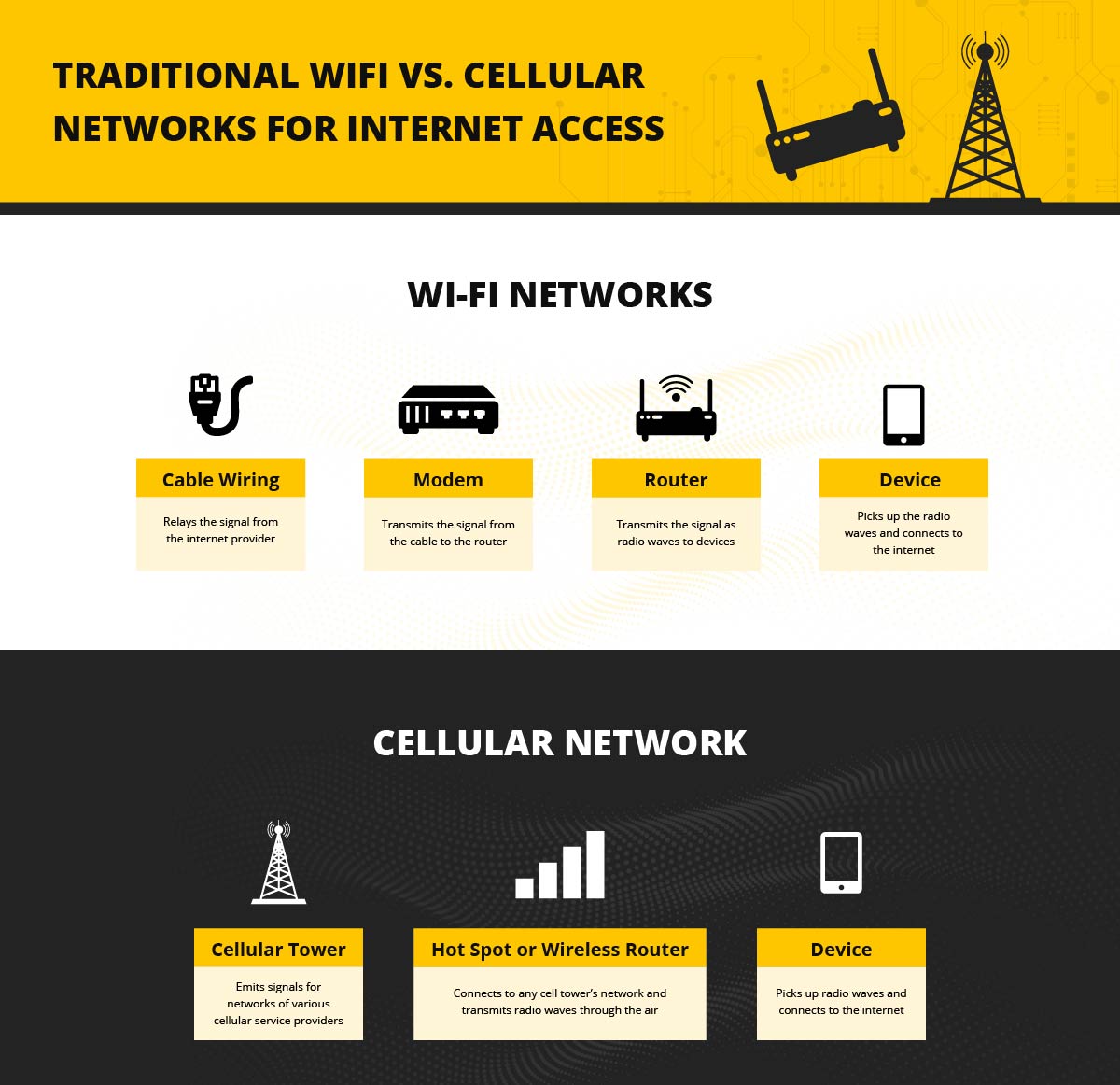How Wireless Internet Works
Modern connectivity heavily depends on the interplay between wired and wireless internet technologies. Understanding how wireless internet works is essential. Wireless internet transmits data through the air using advanced technologies such as radio waves, frequency bands, and sophisticated modulation techniques. However, wired infrastructure like fiber optics can also determine how fast wireless internet is and how well it works.
Wireless technology plays an important role in enabling connectivity in diverse environments. In urban settings, wireless internet is supported by dense infrastructure, such as cellular towers and fiber backhaul networks, providing seamless access to Wi-Fi, 4G LTE, and 5G technologies.
In rural areas, things are a little trickier. While wireless solutions can extend connectivity to these regions, understanding how wireless internet works reveals why the quality and speed often lag because of infrastructure limitations. But this too is changing.
In this article, we will further discuss the mechanics of wireless internet, exploring its role in powering localized solutions like Wi-Fi for homes and offices as well as wide-reaching networks like 4G LTE and 5G. This will help you better understand how we are able to bridge the gap between wired infrastructure and end-user devices. Our wireless technologies provide reliable internet and allow our customers to stay connected wherever they are, even in rural settings. But, what is wireless internet and how does it work?
What Wireless Internet Is And How It Works
Wireless internet refers to internet access transmitted without physical cables, typically using Wi-Fi (which relies on radio waves) to send data between devices and a router or using cellular signals to access mobile data.
These waves operate within a set of predefined frequency bands. This is important because managing these frequencies efficiently avoids interferences and helps internet providers to ensure that users experience fast and reliable connections.
Radio Waves and Frequency Bands
Radio waves, which are a type of electromagnetic wave, carry data in the form of modulated signals. These signals are transmitted through the air and can be received by compatible devices like your smartphone, laptop, and router.
Another aspect of how wireless internet works is the wireless spectrum which is divided into various frequency bands, each assigned to different types of communication. This means that cellular networks, Wi-Fi, Bluetooth, and others, each have their own frequency bands.
The frequency bands are governed by regulatory bodies like the Federal Communications Communications (FCC) which allocate bands specifically for wireless communications to avoid signal interference and ensure fair use. For instance, Wi-Fi networks typically operate in the 2.4 GHz and 5GHz bands, while 4G and 5G cellular networks use higher frequency ranges.
Modulation and Signal Processing
Modulation and signal processing are important in determining how fast wireless internet is, among other things.
In the modulation process, data is encoded into radio waves, a key aspect of how wireless internet works, which are then transmitted and decoded at the receiver’s end into meaningful information.
There are many modulation techniques and they vary depending on the type of wireless communication and its requirements. For instance, Orthogonal Frequency Division Multiplexing (OFDM) is a popular technique used in Wi-Fi and cellular networks because it allows for the efficient use of the available spectrum, minimizing interference and improving throughput.

The Evolution of Wireless Internet
Wireless internet had its early beginnings with analog technologies like 2G. Over the past few decades, our understanding of how wireless internet works has led to multiple iterations that have significantly enhanced the speed, reliability, and accessibility of wireless internet, culminating in the ultra-fast, low-latency 5G networks we use today.
Let’s briefly discuss some relevant forms of wireless internet today.
Wi-Fi
Wi-Fi, short for Wireless Fidelity, is probably the most common form of wireless internet for homes and businesses. It operates using the IEEE 802.11 family of standards and typically provides internet access over short to medium-range distances like your home or office building.
Wi-Fi significantly reduced the need for physical ethernet cables, and this has become a major part of how wireless internet works in its “last mile” connections. This is why devices like laptops and smartphones can now also access the internet from virtually anywhere within the network’s range.
Cellular Networks: 2G to 5G
Today, how fast your wireless internet is can also depend on which cellular network you are on.
Cellular networks started with the 2G network in the early 1990s, bringing digital voice and low-speed data to mobile devices. 3G then came along, with faster internet speeds that made mobile browsing, email, video calling, and more possible.
In the late 2000s, 4G LTE (Long-Term Evolution) expanded the limits of how wireless internet works by offering much faster speeds and better reliability than the previous two networks. As a result, this led to the rise of high-definition video streaming, gaming, and so much more on mobile devices.
But the technology is still evolving and the most recent advancement is 5G. 5G comes with better speeds, lower latency, and more stable connections than the previous generations. It uses a combination of frequency bands, including millimeter-wave frequencies that allow it to achieve these much higher speeds.
5G is redefining wireless internet and is capable of supporting technologies like network slicing and massive machine-type communications essential for IoT and smart cities while also improving our wireless internet experiences for our day-to-day internet needs.
Stay Connected Anywhere With Reliable Wireless Internet
Understanding what wireless internet is and how it works shows just how transformative it is for modern connectivity–whether through Wi-Fi or advanced cellular networks like 4G LTE and 5G. But for rural areas and travelers, finding reliable, fast internet can still be a challenge.
That’s where Unlimited LTE Advanced comes in. Whether or not you understand how wireless internet works, our plug-and-play devices use advanced virtual SIM technology to automatically connect to you the strongest available high-speed internet wherever you are.
We also have 24/7 customer support making it easy for you to stay connected. Whether you’re working, streaming, or exploring, Unlimited LTE Advanced has you covered. Get started today with a free consultation and enjoy the internet without limits. Order now and experience hassle-free connectivity.




